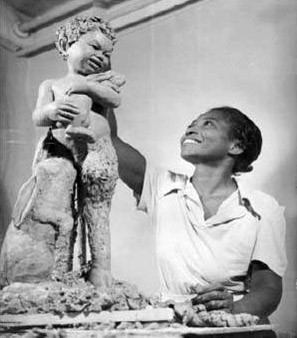Earlier this year the artist Lorna Simpson gave a video tour of her new studio in Brooklyn. It was white, bright and expansive. When Simpson appeared on the screen to speak about the space, she exuded the calm and certitude one expects from an artist of her magnitude. The video was created for an exhibit of the work of British architect David Adjaye. The tour also functioned as a phenomenal display of fortitude and presence. Black women artists like Lorna Simpson, Kara Walker, and Mickalene Thomas are esteemed in the Art world, but the portrait of the artist in the studio is still overwhelmingly that of a white man.
The portrait of the artist in the studio is a meaningful image. In The New Yorker, Lilly Lampe articulates its power. "The studios of famous artists are fascinating for the double insight they provide us: on the one hand, a view of the creative process; on the other, a view of the creative life." The artist in the studio also provides a view of what is possible.
Selma Hortense Burke
Sculptor
Augusta Savage
Sculptor
Elizabeth Catlett
Printmaker and Sculptor
Dr. Samella Lewis
Painter and Printmaker
Simpson's studio tour inspired me to find pictures and videos of black
women artists ensconced in their creative workplaces. In some
of the photographs the artists are in the midst of creation; in others they
are posed next to or in front of a completed piece. There is a sense of pride
and accomplishment in the photos. Seeing those artists in the realms of their
creation is a reminder of the audacious feat of black American women making art
and claiming the professional title of 'artist'. In an interview with Charles H.
Rowell of Callaloo, Lois Mailou Jones spoke about the struggles
of being a black woman artist in the mid-20th century. "I owed very much
to my white friend Céline who would take my paintings to the juries. They never
knew that the artist was black. That was very much in my favor. It's been a
very unusual career. I would also send or ship my work to the Philadelphia
Academy or to the National Academy of Design. Invariably, the works would be
hung, and they would never know that the artist was black. I remember going to
the Philadelphia Academy to see one of my paintings which had been accepted.
While I stood there looking at it, the guard saw me looking at the painting and
said, "I guess you like art, don't you?" I said to myself that he
doesn't know that the painting is mine hanging there. [Much laughter.] And so
that's how it was way back in those early days; I was exhibiting at all of the
big museums, but they never knew that I was black because I either shipped my
works or had a white person deliver them. Now you see how difficult it
was."
Lois Mailou Jones was not alone in being erased from her own work. Sister Rosetta, the mother of Rock and Roll is little known beyond music aficionados and students of African-American history. It is important for black women artists to be seen and acknowledged. Once they are seen, their creative output can be recognized as vital, skillful, and beautiful without qualification. The portrait of the black woman artist in her studio is a statement of being in a world comfortable erasing her from the historical record.
Sculptor
Augusta Savage
Sculptor
Elizabeth Catlett
Printmaker and Sculptor
Dr. Samella Lewis
Painter and Printmaker
Interview with Dr. Lewis begins at :22 seconds
Lois Mailou Jones
Painter
Faith Rinngold
Painter, Sculptor, Perfomance Artist
Betye Saar
Painter, Multimedia and Installation Artist
Kara Walker
Mixed-media, Sculptor, Painter, Video and Silhouette Artist
Mickalene Thomas
Painter
Lorna Simpson
Photographer








No comments:
Post a Comment